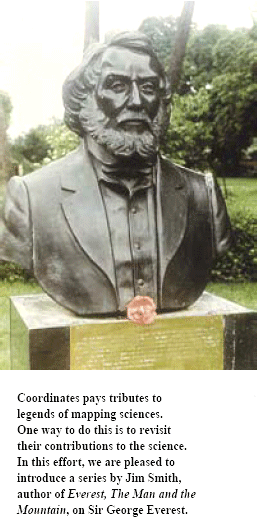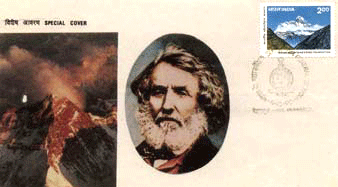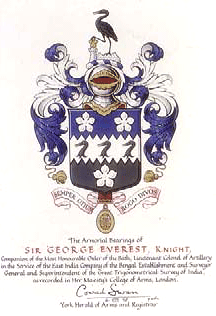| History | |
Remembering Everest
|
|
|||||||||
Beginning with this issue, JR Smith traces the life and work of Sir George Everest
My interest in Everest came about in two ways. Firstly in the early 1980s I had the idea of compiling a history of land surveying. It was soon obvious that it was a far too wide a topic to do justice to so I refined it to a history of geodesy – still in itself a large subject but hopefully manageable. Then around late 1989 it was pointed out to me that 1990 would be the 200th anniversary of the death of Sir George Everest. At that period I was much involved in the Royal Institution of Chartered Surveyors and its technical meetings and considered that something should be done to commemorate the Everest event. This was to lead to two notable events, one in London and the other in India at Dehra Dun. I began by looking for a biography of him but it soon became apparent that no such volume existed. That seemed strange for a person of his status and the fact that a major world feature was named after him. However it became obvious that such was the case so I took it upon myself to compile what I could. The Survey of India marked this occasion with a gathering in Dehra Dun on 4 October 1990. Many dignitaries and numerous surveyors from around India attended. This was the occasion to launch several special Everest maps and a First Day postal cover. In addition delegates were presented with a memento in the form of a model of the Great Theodolite. The delegates from the U.K. presented the Survey of India through its Surveyor General Lt.Gen.S.M. Chadha with a framed painting of the Everest Coat of Arms as used by Sir George after he retired to England. This painting was specially commissioned by the Royal Institution of Chartered Surveyors and Royal Geographical Society and was executed by the heraldic artist Henry Gray. Various talks were given by a range of notable speakers from India, the U.K. and the United States. That evening special busts were unveiled in the grounds of the Survey of India to commemorate Sir George Everest, Nain Singh and Kishen Singh. At the same time the National Survey Museum was inaugurated by Mrs Suda Gowariker. The following day delegates had the opportunity to visit the Everest Estate in the hills above Mussoorie. Here we could not fail to be captivated by the superb scenery and general location of the Estate. The tragedy was that the building was in ruins and it was hoped by all there that it could be restored and put to some useful surveying purpose such as a survey school. Whether that ever happened is not known. In London, as in India, a special First Day postal cover was launched for 4th July. A Committee was formed and arrangements made for a conference to be held at the Royal Geographical Society in London on 8 November 1990. Some 75 delegates, speakers and guests attended and 8 technical papers presented. Among the guests were the then Surveyor General of India, Lt.Gen.S.M. Chadha and his later successor as Surveyor General, Sri V.K.Nagar; also in attendance were H.E. Maj.Gen. Bharat Kesher Simha from the Royal Nepalese Embassy and Col. Gupta of the Survey of India. The technical papers covered a wide range of aspects including the general Mapping of British India from 1757 to 1830; The Instruments of the Time; Everest’s time at the Cape of Good Hope; His achievements in Geodesy; The New map of Mount Everest; The Present time at the Survey of India and a Short Biography of the Man. During the events a presentation was made by General Chadha to The Royal Institution of Chartered Surveyors of a painting of Everest’s Estate near Mussoorie.
It became obvious as I compiled my contribution to that conference of the short biography of him that sources of information about his personal life were almost non-existent. Hence the reason why no-one had previously tried to compile any story of his life. The reason for this became clear upon perusing some of the published writings of his niece Mary Everest Boole. In one of her articles she said “ .. That circumstances into which I cannot now enter, led to the destruction of nearly all written memorials of his life….”
No other references have so far brought to light what thosecircumstances were although there have been various unsubstantiated suggestions. Unlike most other important scientists and notable persons of his time he appears not to have deposited any of his papers in a national archive for posterity so subsequent researchers had but scattered crumbs to draw upon. This should not be confused with his professional life which as far as the Survey of India is concerned is well documented and archived in Delhi as will be seen as this series progresses. Sparked by the knowledge that this great person had not been written about in any detail and coupled with the interest shown at the events in India and London I set to and gathered as much as I could about him. It is this that will be related in a series of short articles over the coming months. If any readers can add to the information given in any of these instalments or wish to comment on it in any way then I would be very pleased to hear from them. Much of the content will also be found in :- Smith, J.R. 1999. Everest. The Man and the Mountain. Whittles, Scotland.
| |||||||||

















 (4 votes, average: 4.75 out of 5)
(4 votes, average: 4.75 out of 5)


